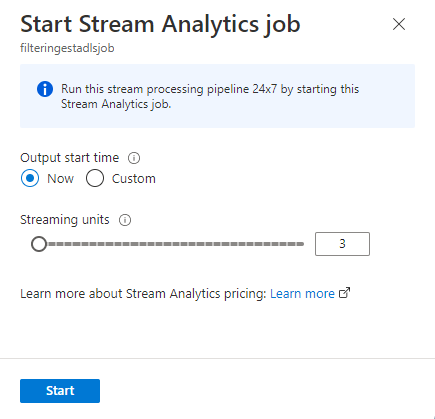Filter and ingest to Azure Data Lake Storage Gen2 using the Stream Analytics no code editor
This article describes how you can use the no code editor to easily create a Stream Analytics job. It continuously reads from your Event Hubs, filters the incoming data, and then writes the results continuously to Azure Data Lake Storage Gen2.
Prerequisites
- Your Azure Event Hubs resources must be publicly accessible and not be behind a firewall or secured in an Azure Virtual Network
- The data in your Event Hubs must be serialized in either JSON, CSV, or Avro format.
Develop a Stream Analytics job to filter and ingest real time data
In the Azure portal, locate and select the Azure Event Hubs instance.
Select Features > Process Data and then select Start on the Filter and ingest to ADLS Gen2 card.

Enter a name for the Stream Analytics job, then select Create.

Specify the Serialization type of your data in the Event Hubs window and the Authentication method that the job will use to connect to the Event Hubs. Then select Connect.

If the connection is established successfully and you have data streams flowing in to the Event Hubs instance, you'll immediately see two things:
- Fields that are present in the input data. You can choose Add field or select the three dot symbol next to each field to remove, rename, or change its type.

- A live sample of incoming data in Data preview table under the diagram view. It automatically refreshes periodically. You can select Pause streaming preview to see a static view of sample input data.

- Fields that are present in the input data. You can choose Add field or select the three dot symbol next to each field to remove, rename, or change its type.
Select the Filter tile. In the Filter area, select a field to filter the incoming data with a condition.

Select the Azure Data Lake Storage Gen2 tile. Select the Azure Data Lake Gen2 account to send your filtered data:
- Select the subscription, storage account name, and container from the drop-down menu.
- After the subscription is selected, the authentication method and storage account key should be automatically filled in. Select Connect.
For more information about the fields and to see examples of path pattern, see Blob storage and Azure Data Lake Gen2 output from Azure Stream Analytics.

Optionally, select Get static preview/Refresh static preview to see the data preview that will be ingested from Azure Data Lake Storage Gen2.

To start the job, specify the number of Streaming Units (SUs) that the job runs with. SUs represents the amount of compute and memory allocated to the job. We recommended that you start with three and then adjust as needed.
After you select Start, the job starts running within two minutes and the metrics will be open in tab section below.
You can see the job under the Process Data section in the Stream Analytics jobs tab. Select Refresh until you see the job status as Running. Select Open metrics to monitor it or stop and restart it, as needed.
Here's a sample Metrics page:
Verify data in Data Lake Storage
You should see files created in the container you specified.
Download and open the file to confirm that you see only the filtered data. In the following example, you see data with SwitchNum set to US.
{"RecordType":"MO","SystemIdentity":"d0","FileNum":"548","SwitchNum":"US","CallingNum":"345697969","CallingIMSI":"466921402416657","CalledNum":"012332886","CalledIMSI":"466923101048691","DateS":"20220524","TimeType":0,"CallPeriod":0,"ServiceType":"S","Transfer":0,"OutgoingTrunk":"419","MSRN":"1416960750071","callrecTime":"2022-05-25T02:07:10Z","EventProcessedUtcTime":"2022-05-25T02:07:50.5478116Z","PartitionId":0,"EventEnqueuedUtcTime":"2022-05-25T02:07:09.5140000Z", "TimeS":null,"CallingCellID":null,"CalledCellID":null,"IncomingTrunk":null,"CalledNum2":null,"FCIFlag":null} {"RecordType":"MO","SystemIdentity":"d0","FileNum":"552","SwitchNum":"US","CallingNum":"012351287","CallingIMSI":"262021390056324","CalledNum":"012301973","CalledIMSI":"466922202613463","DateS":"20220524","TimeType":3,"CallPeriod":0,"ServiceType":"V","Transfer":0,"OutgoingTrunk":"442","MSRN":"886932428242","callrecTime":"2022-05-25T02:07:13Z","EventProcessedUtcTime":"2022-05-25T02:07:50.5478116Z","PartitionId":0,"EventEnqueuedUtcTime":"2022-05-25T02:07:12.7350000Z", "TimeS":null,"CallingCellID":null,"CalledCellID":null,"IncomingTrunk":null,"CalledNum2":null,"FCIFlag":null} {"RecordType":"MO","SystemIdentity":"d0","FileNum":"559","SwitchNum":"US","CallingNum":"456757102","CallingIMSI":"466920401237309","CalledNum":"345617823","CalledIMSI":"466923000886460","DateS":"20220524","TimeType":1,"CallPeriod":696,"ServiceType":"V","Transfer":1,"OutgoingTrunk":"419","MSRN":"886932429155","callrecTime":"2022-05-25T02:07:22Z","EventProcessedUtcTime":"2022-05-25T02:07:50.5478116Z","PartitionId":0,"EventEnqueuedUtcTime":"2022-05-25T02:07:21.9190000Z", "TimeS":null,"CallingCellID":null,"CalledCellID":null,"IncomingTrunk":null,"CalledNum2":null,"FCIFlag":null}
Considerations when using the Event Hubs Geo-replication feature
Azure Event Hubs recently launched the Geo-Replication feature in public preview. This feature is different from the Geo Disaster Recovery feature of Azure Event Hubs.
When the failover type is Forced and replication consistency is Asynchronous, Stream Analytics job doesn't guarantee exactly once output to an Azure Event Hubs output.
Azure Stream Analytics, as producer with an event hub an output, might observe watermark delay on the job during failover duration and during throttling by Event Hubs in case replication lag between primary and secondary reaches the maximum configured lag.
Azure Stream Analytics, as consumer with Event Hubs as Input, might observe watermark delay on the job during failover duration and might skip data or find duplicate data after failover is complete.
Due to these caveats, we recommend that you restart the Stream Analytics job with appropriate start time right after Event Hubs failover is complete. Also, since Event Hubs Geo-replication feature is in public preview, we don't recommend using this pattern for production Stream Analytics jobs at this point. The current Stream Analytics behavior will improve before the Event Hubs Geo-replication feature is generally available and can be used in Stream Analytics production jobs.
Next steps
Learn more about Azure Stream Analytics and how to monitor the job you've created.




